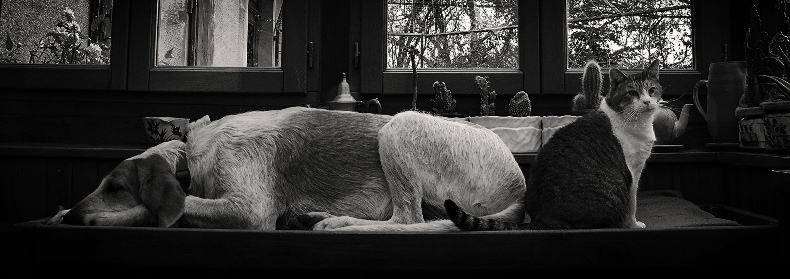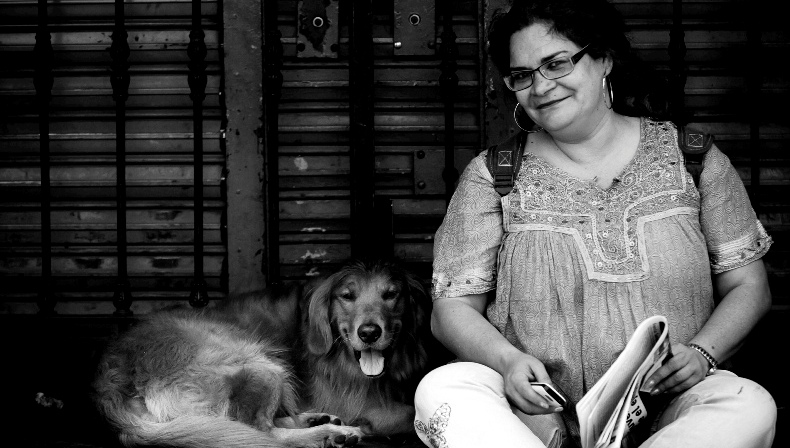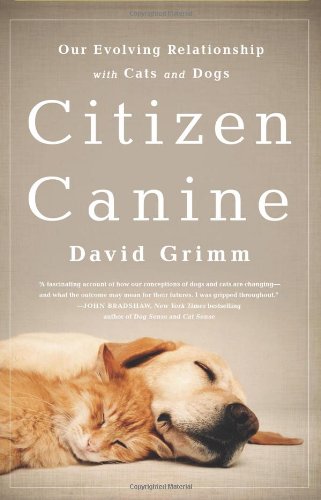 One of the most fascinating tidbits I came across while researching my new book, Citizen Canine: Our Evolving Relationship with Cats and Dogs, concerns the 10,000-year-old village of Shillourokambos. Located on the Mediterranean island of Cyprus, the site was once home to an early farming community whose inhabitants stored grain in stone silos and corralled livestock behind wood fences. In 2001, archaeologists digging beneath the foundation of what was once a small, circular house made a surprising discovery: a shallow grave containing the skeleton of a human, and next to it, surrounded by carved seashells, the remains of a cat.
One of the most fascinating tidbits I came across while researching my new book, Citizen Canine: Our Evolving Relationship with Cats and Dogs, concerns the 10,000-year-old village of Shillourokambos. Located on the Mediterranean island of Cyprus, the site was once home to an early farming community whose inhabitants stored grain in stone silos and corralled livestock behind wood fences. In 2001, archaeologists digging beneath the foundation of what was once a small, circular house made a surprising discovery: a shallow grave containing the skeleton of a human, and next to it, surrounded by carved seashells, the remains of a cat.
That wasn’t the fascinating part. Archaeologists had long suspected that cats first entered human society to hunt the rodents that early farming villages attracted. What surprised me was learning that the Shillourokambians had shipped in foxes for the same purpose. And yet only cats became pets. Dogs, likewise, became treasured companions when plenty of other animals could have theoretically fit the bill. Of all the species on earth, only two have morphed from wild animal to family member. It’s a process that took thousands of years.
And yet, as we were transforming these animals, they were also transforming us.
 The first evidence for this doesn’t crop up until the late nineteenth century. This was a period when pets spent most of their time outdoors: cats prowled barns and sheds; dogs were chained up in the yard or confined to doghouses. But in the 1880s, the first flea and tick products began to bring dogs inside, and the invention of kitty litter in 1947 did the same for cats. The move indoors was revolutionary: an outdoor pet would always be an animal, but a being that lived in your house and slept in your bed was a member of the family. Companies soon began manufacturing pet “food” (to distinguish it from the “feed” intended for less refined domestic animals), a burgeoning pet supply industry started selling grooming brushes and toy mice, and veterinarians transformed their once dank livestock clinics into state-of-the-art small animal hospitals, offering services that rivaled those of human medicine. Pets became children and vicarious consumers.
The first evidence for this doesn’t crop up until the late nineteenth century. This was a period when pets spent most of their time outdoors: cats prowled barns and sheds; dogs were chained up in the yard or confined to doghouses. But in the 1880s, the first flea and tick products began to bring dogs inside, and the invention of kitty litter in 1947 did the same for cats. The move indoors was revolutionary: an outdoor pet would always be an animal, but a being that lived in your house and slept in your bed was a member of the family. Companies soon began manufacturing pet “food” (to distinguish it from the “feed” intended for less refined domestic animals), a burgeoning pet supply industry started selling grooming brushes and toy mice, and veterinarians transformed their once dank livestock clinics into state-of-the-art small animal hospitals, offering services that rivaled those of human medicine. Pets became children and vicarious consumers.
But bringing pets indoors didn’t just change them—it changed us. In the late nineteenth century, the middle-class abode had become a domestic haven, a refuge from an increasingly rough and industrial world. Father paid the bills, and mother made sure her children grew up civilized. Women believed that if they didn’t teach their sons and daughters kindness from an early age, they would grow into savage human beings. The home became a laboratory for building better human beings.
If home was a laboratory, then pets were the guinea pigs. Now that cats and dogs were spending more time inside, mom could use them as surrogates for how to treat people in the outside world. She had some help from well-known authors like Harriet Beecher Stowe. In an essay titled “Aunt Esther’s Rules,” the famed abolitionist admonished children not to abandon dogs and cats in the woods, where they would wander homeless and be abused. “The care of the defenseless animal creation,” she wrote in another essay, “is to be an evidence of the complete triumph of Christianity.”
While pets were helping to turn children into more civilized human beings, they were also civilizing society. Just a couple of decades before dogs and cats began to enter the home, a wealthy Manhattan socialite named Henry Bergh founded the nation’s first animal welfare organization, the American Society for the Prevention of Cruelty to Animals. Horses were being beaten to death on New York streets, and homeless dogs and cats were drowned and strangled to control their numbers. Bergh contended that a civilized society should not tolerate such cruelties, and his arguments were so persuasive that New York not only sanctioned his ASPCA, but gave him his own police force to fight cruelty on the streets. Bergh also convinced the state to pass America’s toughest animal welfare law, which made it a misdemeanor to harm dogs, cats, and other creatures. “This is purely a matter of conscience,” he proclaimed. “It has no perplexing side issues.”
 Today, that misdemeanor has become a felony nationwide. Helping to make that happen was the Humane Society of the United States, an organization founded, in part, to combat the seizing of cats and dogs from municipal pounds for use in biomedical research. In the mid-1980s, the HSUS started collating a growing body of scientific literature that showed that people who abused animals were far more likely to abuse and murder human beings. Thanks to the felony anti-cruelty laws that resulted from this effort, animal abusers can now be thrown in prison for up to 10 years and fined as much as $125,000. The Los Angeles Police Department even has its own animal cruelty task force, which, when it hauls people to jail for animal crimes, is also taking gangsters and child abusers off the streets.
Today, that misdemeanor has become a felony nationwide. Helping to make that happen was the Humane Society of the United States, an organization founded, in part, to combat the seizing of cats and dogs from municipal pounds for use in biomedical research. In the mid-1980s, the HSUS started collating a growing body of scientific literature that showed that people who abused animals were far more likely to abuse and murder human beings. Thanks to the felony anti-cruelty laws that resulted from this effort, animal abusers can now be thrown in prison for up to 10 years and fined as much as $125,000. The Los Angeles Police Department even has its own animal cruelty task force, which, when it hauls people to jail for animal crimes, is also taking gangsters and child abusers off the streets.
We’ve become a kinder culture when it comes to other animals too. Opposition to animal research is at an all-time high, with 54% of Americans aged 18 to 29 finding the practice morally wrong—nearly double the number it was 15 years ago. The public is also growing increasingly uncomfortable with seeing whales and dolphins in captivity, and in the last decade we’ve passed an unprecedented number of laws to protect livestock and wildlife. All of these trends mirror the rise of cats and dogs as bona-fide family members: 83% of owners now refer to themselves as their pet’s “mom” or “dad”, up from 55% just 20 years ago. Today’s children aren’t growing up with their dogs and cats as pets or even companions; they’re growing up with them as virtual siblings. And that’s allowing them to see the lives of all animals through the eyes of their cats and dogs.
All of this may explain why we’re a more humane society than we’ve ever been, one more concerned about both human and animal suffering than at any point in our history. Thousands of years ago, we began the long, slow process of domesticating our pets. Now they have domesticated us.
________
David Grimm is a deputy news editor at Science and the author of the new book, Citizen Canine: Our Evolving Relationship with Cats and Dogs.
Photos: Nebojsa Mladjenovic, via Flickr; Jorge Mexicano, via Flickr
An interesting extension of this article would be to look at how pets are treated in other countries and how, or if, that behavior is changing. Is that in the book?
Hi Dave, thanks for your comment. I do indeed talk in the book about the rising pet population in both China and India and what impact it may have on those countries. I hope you’ll grab a copy!